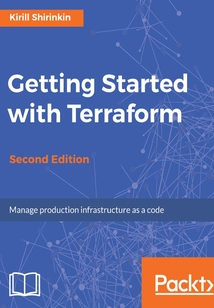首頁 > 計算機(jī)網(wǎng)絡(luò) >
編程語言與程序設(shè)計
> Getting Started with Terraform(Second Edition)最新章節(jié)目錄
舉報 

會員
Getting Started with Terraform(Second Edition)
最新章節(jié):
Summary
Thisbookisfordevelopersandoperatorswhoalreadyhavesomeexposuretoworkingwithinfrastructurebutwanttoimprovetheirworkflowandintroduceinfrastructureasacodepractice.KnowledgeofessentialAmazonWebServicescomponents(EC2,VPC,IAM)wouldhelpcontextualizetheexamplesprovided.BasicunderstandingofJenkinsandShellscriptswillbehelpfulforthechaptersontheproductionusageofTerraform.
目錄(130章)
倒序
- cover
- Title Page
- Getting Started with Terraform
- Second Edition
- Copyright
- Getting Started with Terraform
- Second Edition
- Credits
- About the Author
- About the Reviewer
- www.PacktPub.com
- Why subscribe?
- Customer Feedback
- Preface
- What this book covers
- What you need for this book
- Who this book is for
- Conventions
- Reader feedback
- Customer support
- Downloading the example code
- Downloading the color images of this book
- Errata
- Piracy
- Questions
- Infrastructure Automation
- What is Infrastructure as Code and why is it needed?
- Declarative versus procedural tools for Infrastructure as Code
- Infrastructure as Code in the Cloud
- Requirements for infrastructure provisioner
- Supports a wide variety of services
- Idempotency
- Dependency resolution
- Robust integration with existing tools
- Platform agnosticism
- Smart update management
- Ease of extension
- Which tools exist for infrastructure provisioning?
- Scripting
- Configuration management
- CloudFormation/Heat
- Terraform
- A short overview of Terraform
- Journey ahead and how to read this book
- Summary
- Deploying First Server
- History of Terraform
- Preparing work environment
- The many Terraform providers
- Short introduction to AWS
- Using Elastic Compute Cloud
- Creating an instance through the Management Console
- Creating an instance with AWS CLI
- Configuring AWS provider
- Static credentials
- Environment variables
- Credentials file
- Creating an EC2 instance with Terraform
- Working with state
- Handling resource updates
- Destroying everything we've built
- Summary
- Resource Dependencies and Modules
- Creating an AWS Virtual Private Cloud
- Understanding dependency graph
- Playing with Terraform graphs
- Controlling dependencies with depends_on and ignore_changes
- Making sense of our template
- Removing duplication with modules
- Configuring modules
- Retrieving module data with outputs
- Using root module outputs
- Summary
- Storing and Supplying Configuration
- Understanding variables
- Using map variables
- Using list variables
- Supplying variables inline
- Using Terraform environment variables
- Using variable files
- Configuring data sources
- Providing configuration with template_file
- Providing data from anywhere with external_data
- Exploring Terraform configuration resources
- Taking a quick look at Consul
- Summary
- Connecting with Other Tools
- Returning data with outputs
- Testing servers with Inspec
- Provisioners
- Provisioning with local-exec and Ansible
- Provisioning with Chef
- Provisioning with remote-exec and Puppet
- Uploading files with a file provisioner
- Reprovisioning machines with null_resource
- Using third-party plugins
- Summary
- Scaling and Updating Infrastructure
- Counting servers
- Bringing in high availability
- Load balancing and simulating conditionals
- Immutable infrastructure
- Baking images with Packer
- Rolling out AMI upgrades with Terraform
- Performing blue-green deployments
- Refreshing infrastructure
- Importing resources
- Summary
- Collaborative Infrastructure
- Version control with Git 101
- Moving templates to Git
- Protecting secrets in a Git repository
- Storing state files remotely
- Connecting remote states together
- Storing modules remotely
- Locking state files with Terragrunt
- Moving infrastructure updates to the CI pipeline
- Integration testing of Terraform modules
- Summary
- Future of Terraform
- Infrastructure as code and Terraform replacements
- Learning AWS and compiling Terraform
- Learning Consul
- Provisioning and configuration management
- Immutable infrastructure
- Collaboration and CI/CD
- The many tools around Terraform
- The rapid development of Terraform
- Closing thoughts on the future of Terraform
- Summary 更新時間:2021-07-15 17:06:59
推薦閱讀
- 微服務(wù)設(shè)計(第2版)
- C語言程序設(shè)計(第3版)
- Getting started with Google Guava
- Python for Secret Agents:Volume II
- Learning Firefox OS Application Development
- 零基礎(chǔ)學(xué)Python數(shù)據(jù)分析(升級版)
- The DevOps 2.5 Toolkit
- Apache Spark 2.x for Java Developers
- C語言程序設(shè)計
- Mastering Backbone.js
- Django 3.0應(yīng)用開發(fā)詳解
- UX Design for Mobile
- Practical Maya Programming with Python
- AI輔助編程Python實(shí)戰(zhàn):基于GitHub Copilot和ChatGPT
- HTML5+jQuery Mobile移動應(yīng)用開發(fā)
- SAP HANA Starter
- Unity與C++網(wǎng)絡(luò)游戲開發(fā)實(shí)戰(zhàn):基于VR、AI與分布式架構(gòu)
- Mastering High Performance with Kotlin
- PHP面試一戰(zhàn)到底
- 活文檔:與代碼共同演進(jìn)
- 思維黑客:讓大腦重裝升級的75個超頻用腦法
- Java并發(fā)編程的藝術(shù)
- PrimeFaces Theme Development
- iOS開發(fā)項(xiàng)目化經(jīng)典教程
- Xcode江湖錄
- Java程序設(shè)計基礎(chǔ)教程(慕課版)
- Unity 3.x Game Development by Example Beginner's Guide
- 軟件設(shè)計模式(慕課版)
- Java修煉指南:高頻源碼解析
- SQL Server 2016 Developer's Guide

